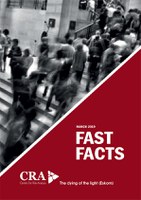
Notably
- Eskom, with a workforce of 48 628 in 2017/18, employs 13 000 more staff than it did a decade ago, but sells less electricity.
- There is a widening gap between demand for electricity and electricity sales. A decline in sales compels Eskom to increase tariffs to recover its fixed operational and maintenance expenses. This in turn incentivises consumers to move off-grid, further eroding the customer base.
- The alternative to tariff increases is a bailout from government, which already guarantees R350 billion of Eskom’s now over R400 billion debt.
- Renewable energy sources such as solar, hydro and wind power have produced a negligible amount of electricity.
- Bold policy reform is needed, such as reducing the wage bill, appointing staff on merit, and giving greater autonomy to the Eskom board.
The Fast Stats pages, with financial and other statistics, are included.
